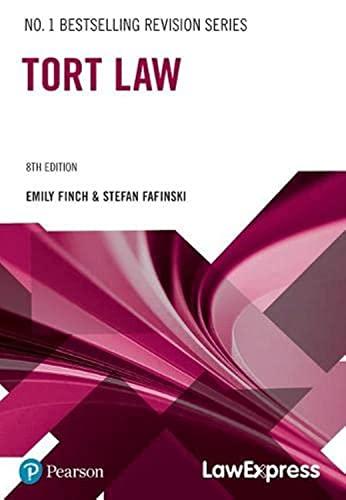Question
Legal and Ethical Scenarios Select two of the scenarios provided below. Analyze the facts in the scenarios and develop appropriate arguments and recommendations using case
Legal and Ethical Scenarios
Selecttwoof the scenarios provided below. Analyze the facts in the scenarios and develop appropriate arguments and recommendations using case law and scholarly sources. Do not copy the case studies into the paper. Cite your sources on a separate page. Submit the paper to theSubmissions Areabythe due date assigned.
Scenario 1Bankruptcy
Katrina, a risk manager for State Farm Insurance, filed a petition in bankruptcy under Chapter 7, seeking to discharge $55,000 in credit-card debts and $35,000 in student loans.Katrina's husband died and left her with two children, Paula, who attended college, and Dean, who was fifteen years old.According to Katrina, Dean was an "elite" runner who practiced ten to fifteen hours a week and placed first or second at more than forty competitive events. Dean was homeschooled with academic achievements that were average for his grade level.Katrina's petition showed monthly income of $5,400 and expenses of $5,100.The expenses included annual homeschool costs of $6,200 and annual running expenses of $7,500.The expenses did not include college costs for Paula, or airfare for her upcoming summer trip to Italy, and other items.The trustee allowed monthly expenses of $4,400, with nothing allocated for running expenseand asked the court to dismiss the petition.
- If Katrina qualified for Chapter 7, which debts would be discharged?Which debts would not be discharged?Why?
- Using the median income from your state, does Katrina qualify for Chapter 7?Remember to count the number of people in the household.
- Should the court grant the trustee's request?Does Katrina have other options if the Chapter 7 petition is dismissed?
- Explain your answers and support them with relevant scholarly sources.
Scenario II - Insurance
Juanita owns a home in Birmingham, Alabama.Her elderly grandmother lives in the house so Juanita can help take care of her.Juanita decides to purchase a fire insurance policy from Allstate to cover the house and a life insurance policy from Liberty Mutual to cover funeral and other expenses that will be incurred when her grandmother dies.Six months later, Juanita sells the house to Ben.Juanita and her grandmother move into a rental home.One month prior to the expiration of the fire insurance, Juanita's old house burns to the ground.Shortly after, her grandmother dies.The insurance companies state that they are not liable because Juanita did not have an insurable interest in the home or her grandmother.The premiums were returned to Juanita.
- Discuss the claims for all parties (Juanita, Allstate and Liberty).
Scenario III Bankruptcy
Locate one of the following scholarly articles about bankruptcy in the SUO Online Library.Summarize the article.Identify and discuss the most important aspect of the article, as well as any ethical issues.
Adkisson, R. V., & Saucedo, E. (2012). Emulation and state-by-state variations in bankruptcy rates.The Journal of Socio-Economics, 41(4), 400. doi:10.1016/j.socec.2012.04.008
Boettcher, J., Cavanagh, G., & Xu, M. (2014). Ethical Issues that arise in Bankruptcy.Business & Society Review (00453609),119(4), 473-496. doi:10.1111/basr.12042
Crack, T. F., & Roberts, H. (2015). Credit cards, excess debt, and the time value of money: The parable of the debt banana.Journal of Financial Education, 41(1), 117-137.
Grote, K. R., & Matheson, V. A. (2014). The impact of state lotteries and casinos on state bankruptcy filings.Growth & Change, 45(1), 121-135. doi:10.1111/grow.12030
Joseph, M. B. (2016). Consumer pro se bankruptcy: Finding hope in hopelessness.American Bankruptcy Institute Journal, 35(5), 32-33.
Labatt, J., Forrest, M., & Swartz, R. (2016). Discharging student loans in bankruptcy: Good luck with that.Proceedings of the Allied Academies International Conference. International Academy for Case Studies, 23(1) 8-11.
McQuade, A. (2016). The antidote to zombie foreclosures: How bankruptcy courts should address the zombie foreclosure crisis.Emory Bankruptcy Developments Journal, 32(2), 507-535.
Pardo, R. I. (2016). Taking bankruptcy rights seriously.Washington Law Review,91(3), 1115-1191.
Ramsey, S., Blough, D., Kirchhoff, A., Kreizenbeck, K., Fedorenko, C., Snell, K., . . . Overstreet, K. (2013). Washington state cancer patients found to be at greater risk for bankruptcy than people without A cancer diagnosis.Health Affairs, 32(6), 1143-52.
Sousa, M. D. (2013). Bankruptcy stigma: A socio-legal study.The American Bankruptcy Law Journal, 87(4), 435-482.
Wikel, D., & Lane, E. (2012). Moral and ethical considerations for turnaround professionals.American Bankruptcy Institute Journal, 31(7), 36-37,88-89.
Step by Step Solution
There are 3 Steps involved in it
Step: 1

Get Instant Access to Expert-Tailored Solutions
See step-by-step solutions with expert insights and AI powered tools for academic success
Step: 2

Step: 3

Ace Your Homework with AI
Get the answers you need in no time with our AI-driven, step-by-step assistance
Get Started


